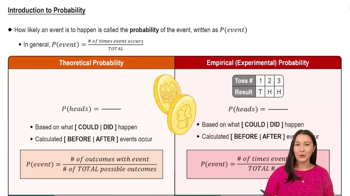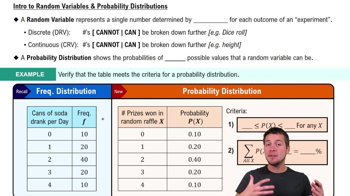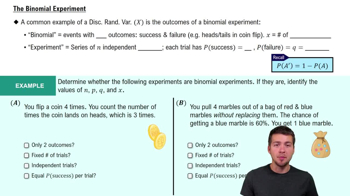Teed Off When four golfers are about to begin a game, they often toss a tee to randomly select the order in which they tee off. What is the probability that they tee off in alphabetical order by last name?
Table of contents
- 1. Intro to Stats and Collecting Data1h 14m
- 2. Describing Data with Tables and Graphs1h 55m
- 3. Describing Data Numerically2h 5m
- 4. Probability2h 16m
- 5. Binomial Distribution & Discrete Random Variables3h 6m
- 6. Normal Distribution and Continuous Random Variables2h 11m
- 7. Sampling Distributions & Confidence Intervals: Mean3h 23m
- Sampling Distribution of the Sample Mean and Central Limit Theorem19m
- Distribution of Sample Mean - Excel23m
- Introduction to Confidence Intervals15m
- Confidence Intervals for Population Mean1h 18m
- Determining the Minimum Sample Size Required12m
- Finding Probabilities and T Critical Values - Excel28m
- Confidence Intervals for Population Means - Excel25m
- 8. Sampling Distributions & Confidence Intervals: Proportion1h 12m
- 9. Hypothesis Testing for One Sample3h 29m
- 10. Hypothesis Testing for Two Samples4h 50m
- Two Proportions1h 13m
- Two Proportions Hypothesis Test - Excel28m
- Two Means - Unknown, Unequal Variance1h 3m
- Two Means - Unknown Variances Hypothesis Test - Excel12m
- Two Means - Unknown, Equal Variance15m
- Two Means - Unknown, Equal Variances Hypothesis Test - Excel9m
- Two Means - Known Variance12m
- Two Means - Sigma Known Hypothesis Test - Excel21m
- Two Means - Matched Pairs (Dependent Samples)42m
- Matched Pairs Hypothesis Test - Excel12m
- 11. Correlation1h 6m
- 12. Regression1h 50m
- 13. Chi-Square Tests & Goodness of Fit1h 57m
- 14. ANOVA1h 57m
4. Probability
Counting
Problem 4.4.24a
Textbook Question
ATM You want to obtain cash by using an ATM, but it’s dark and you can’t see your card when you insert it. The card must be inserted with the front side up and the printing configured so that the beginning of your name enters first.
a. What is the probability of selecting a random position and inserting the card with the result that the card is inserted correctly?
 Verified step by step guidance
Verified step by step guidance1
Step 1: Understand the problem. The card can be inserted in four possible orientations: (1) front side up with the beginning of the name entering first, (2) front side up with the end of the name entering first, (3) back side up with the beginning of the name entering first, and (4) back side up with the end of the name entering first.
Step 2: Identify the favorable outcome. The card is inserted correctly only if it is front side up and the beginning of the name enters first. This is one specific orientation out of the four possible orientations.
Step 3: Calculate the total number of possible outcomes. Since there are four possible orientations for inserting the card, the total number of outcomes is 4.
Step 4: Calculate the probability of the favorable outcome. The probability is given by the formula: \( P = \frac{\text{Number of favorable outcomes}}{\text{Total number of outcomes}} \). Substitute the values: \( P = \frac{1}{4} \).
Step 5: Conclude that the probability of inserting the card correctly is \( \frac{1}{4} \), which represents one favorable outcome out of four possible orientations.
 Verified video answer for a similar problem:
Verified video answer for a similar problem:This video solution was recommended by our tutors as helpful for the problem above
Video duration:
2mPlay a video:
Was this helpful?
Key Concepts
Here are the essential concepts you must grasp in order to answer the question correctly.
Probability
Probability is a measure of the likelihood that a particular event will occur, expressed as a number between 0 and 1. In this context, it refers to the chance of inserting the ATM card correctly based on the possible orientations of the card. Understanding how to calculate probability involves recognizing the total number of favorable outcomes over the total number of possible outcomes.
Recommended video:

Introduction to Probability
Random Selection
Random selection refers to choosing an item or position without any bias or predetermined criteria. In the ATM scenario, it implies that the position where the card is inserted is chosen randomly, which affects the probability of the card being inserted correctly. This concept is crucial for determining how many ways the card can be inserted and how many of those ways are correct.
Recommended video:
Guided course

Intro to Random Variables & Probability Distributions
Outcomes
Outcomes are the possible results of a random experiment. In this case, the outcomes are the different ways the ATM card can be inserted, which include both correct and incorrect orientations. Identifying all possible outcomes is essential for calculating the probability of a successful insertion, as it helps in determining the ratio of favorable outcomes to total outcomes.
Recommended video:
Guided course

The Binomial Experiment

 7:11m
7:11mWatch next
Master Introduction to Permutations with a bite sized video explanation from Patrick
Start learningRelated Videos
Related Practice
Textbook Question
